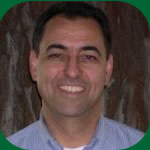Using Ecology to Improve Your Hog Success
by George Visger, "The Wild Guy"
Big Game season is right around the corner, with Coastal
Archery deer season kicking off the parade. Those of us who
are primarily archery hunters have learned that dealing with
heat is part of the game,  particularly during those early July and
August archery hunts. Learning a little about the ecology of your
hunting area (geography, geology, weather patterns, vegetation
and wildlife species) will go miles towards increasing your
success, AND reducing wear and tear on your body.
particularly during those early July and
August archery hunts. Learning a little about the ecology of your
hunting area (geography, geology, weather patterns, vegetation
and wildlife species) will go miles towards increasing your
success, AND reducing wear and tear on your body.
In the early 80’s, when I first took up archery hunting (which became a passion of mine from the first hunt), I believed the more miles you put on your boots, the more game you would see, thus the more successful you would be. It took me many years and several pairs of worn soles to figure out miles covered does not equate to a higher success rate.
To be consistently successful hunting big game in California requires knowledge of the seasonal needs of each species pursued. With early archery season during the peak of the hot season, water and high quality feed drive an animal’s movements. Later in the season, weather (migration for some species) and the rut are the primary motivators. Let's address a question that was posed to me recently:
“Hey Wild Guy. I am new to the club and have never taken a hog before. I have killed 3 deer hunting public land over the years, but never a hog. I am planning on trying to take one with my bow. My question is: when going to a new property and arriving in the dark, how do I know where to start.” Good question.
Take a look at the map of the property, which comes with your land packet. Considering we are located north of the equator, the sun is always to our south. When ever possible, I like to start my hunts on the north facing slopes, which are shaded much longer. Less direct sunlight means more moisture in the soil, thus more succulent forage. It is also cooler, thus areas hogs like to hole up and bed in during the heat of the day. With more moisture in the soil, it is easier for hogs to root for feed during the early seasons, when the rest of the ground is hardpan.
Also look for ponds on the map. Ponds are usually located downstream from a water source, or in the bottom of a gully, which concentrates surface runoff during storm events. Hogs will hit the ponds during the early season mainly in the evening, but you can also catch them at those spots at first light. If there is sign on the pond. such as wallows, you have found a place to start. Hogs need to wallow to cool down as they don’t have sweat glands like you and I do. They will also wallow to get rid of parasites. I like to toss a handful of leaves in the wallow. When checking the next morning you can tell if they have been in there the night before or not.
As hogs can be very nocturnal during the early seasons, they are usually hitting the ponds just before dark and during the night. If you find fresh sign at the pond, work your way uphill, up the nearest gully or drainage that leads into the pond. As you work your way uphill, keep your eyes open for large patches of chemise (Adenostoma fasciculatum). These are favorite bedding areas for hogs. If rifle hunting with a partner or two, you could try a drive through the bedding area, but that’s a technique I rarely recommend. Bust them out of their bedding area and they may line out for several miles and not be back for weeks. A better game plan is to situate yourself down wind of the bedding area in the evening, keeping in mind thermals will switch in the evening as it cools and will flow down hill. Set up where you have a good view of the area and any potential trails to the pond. Make sure you are close enough to the trails so you can make a move to get in position for a shot while you still have enough daylight to work with, yet are not giving your position away with your scent. If nothing comes in before dark, check the map for another pond and do the same.
A favorite saying of mine is, “The hardest part about hunting hogs is just finding them.”
Keep in mind they have great noses but very poor eyesight, and need to stay cool during the summer. They also need the highest quality feed they can find. Use that to your advantage and out think them. You certainly won’t out walk them as I used to try to do.
Good Luck!
.